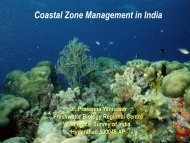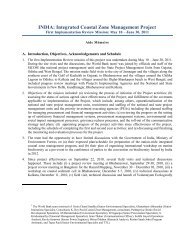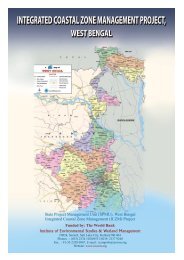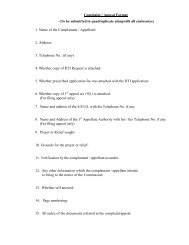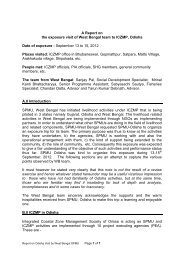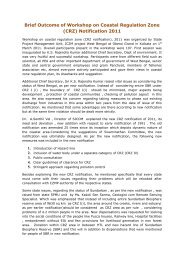Cyclone and Storm Surge - Iczmpwb.org
Cyclone and Storm Surge - Iczmpwb.org
Cyclone and Storm Surge - Iczmpwb.org
You also want an ePaper? Increase the reach of your titles
YUMPU automatically turns print PDFs into web optimized ePapers that Google loves.
2.21<br />
Considering all the interdependencies in relation to the distribution of the flows over the many river<br />
sections, proposed human interventions to alter or to stabilize the course, the size <strong>and</strong> the shape of<br />
any section should not only be valued on their effects on the local situation <strong>and</strong> their sustainability but<br />
also on the changes these interventions might initiate in the pattern of flows <strong>and</strong> discharges in the<br />
adjacent river sections.<br />
At present not much information is available about the configuration, the fluctuations of the water<br />
levels <strong>and</strong> the pattern of flows which are the results of the combination of storage <strong>and</strong> the<br />
propagation of the tide.<br />
Whatever the configuration of the maze of waterways might be <strong>and</strong> whatever the sizes <strong>and</strong> the<br />
shapes of the river sections might have, their various average depths are smaller during low tide than<br />
during high tide. Incoming tide starts with certain depths <strong>and</strong> these depths will increase till the end of<br />
the incoming tide. With outgoing tides however the depths will become less from its start till its end.<br />
Due to this <strong>and</strong> the effects on the propagation velocity, the period of incoming tide will become<br />
shorter <strong>and</strong> the outgoing tide will become longer for the river sections according as their distance to<br />
the sea. As the volumes that are moving in <strong>and</strong> out are about equal, the incoming currents are<br />
stronger than the outgoing for all sections except those very close to the sea; where the currents are<br />
equally strong. This phenomenon is important for the process of erosion <strong>and</strong> sedimentation in the<br />
estuary.<br />
2.4.9. Role of tidal channels<br />
The energy which creates the tidal flow, viz. attraction of the sun <strong>and</strong> the moon in the deep sea, is<br />
manifested partly as potential energy viz. rise in tide level <strong>and</strong> partly as Kinetic energy viz. velocity of<br />
flow. The formal causes the tidal flow up the rivers <strong>and</strong> the latter determines its power of transporting<br />
silt. As the velocity of tide when it enters the mouths of these tidal rivers is high <strong>and</strong> as there is a vast<br />
reservoir of unconsolidated silt in suspension along the delta-face, the tide as it flows up these rivers,<br />
is highly charged with silt. The duration of Ebb tide in a tidal river is much longer than that of the flow<br />
tide in upper reach. Hence the average velocity of Ebb is less than that of the flow. Thus the Ebb tide<br />
is unable to transport back fully the silt carried by flow tide. Even a slight deposition of the silt will go<br />
on accumulating as the tides function twice daily through out the year. Thus the tide channels<br />
perform the most important function of raising the delta up to highest tide level <strong>and</strong> made fit for<br />
human habitation unless there is human interference. If the tidal channels <strong>and</strong> creeks are allowed to<br />
perform their above responsibility of raising l<strong>and</strong> to optimum elevation the drainage of the l<strong>and</strong> thus







